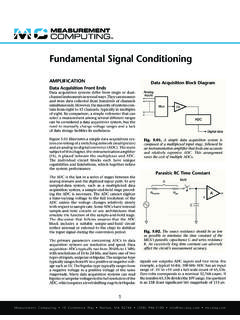Transcription of 3 Troubleshooting a 4-20mA loop - Devar Inc.
1 Analog Advise Devar , Inc. 2014 Troubleshooting a 4/ 20ma loop Page 1 of 4 The basic layout of every 4/ 20ma loop consists of a power supply, a transmitter, and passive loop devices. The supply produces the energy to run the loop. The transmitter controls the current through the loop. The loop devices provide feedback to the world, whether it is an indicator displaying the measured quantity from the transmitter, or some type of relay output control device. Loop devices can also be passive (loop powered) or active (has a power supply) signal transformation devices. For instance, these can be isolators of transform the 4/ 20ma to some other electrical signal, such as 0/10V.
2 To troubleshoot a 4/ 20ma loop electrically, one must use a Digital Volt Meter. The DVM should be able to read Volts and milliAmps DC. Besides the usual sources, a suitable DVM can be found in the hardware stores, auto parts stores, and department stores. One should also know how to use the DVM. It is possible to damage the loop, the DVM, or yourself by using it improperly. Voltage is measured by attaching the DVM leads across the device, essentially attaching the DVM in parallel with the device. Current is measured by attaching the DVM in series with the circuit. The loop wire must be disconnected, and the DVM attached into the circuit to cause all the current to run through the DVM. A malfunctioning 4/ 20ma loop can be caused by many things.
3 The first thing to do is determine where the problem is. Problems can be caused by power, wiring, or loop device issues. If the loop does not appear to function in any manner then one should first check the power and wiring. If it appears that the loop is functioning in some manner then the nature of the malfunction becomes important. If the only malfunction is that the display is reading the wrong numbers, then you should first investigate setting up the display. Please refer to the display manual or the setting up document in this series. Otherwise, start with the loop device section. Power The first step in Troubleshooting any circuit is to check the power supplies. Measure the loop power supply voltage, and ensure that it is at the proper level.
4 1) If the supply output is zero, determine if the supply is being powered, if a fuse is blown, or if the supply is damaged. 2) If the supply voltage is a little low, check to see if the supply is unregulated. Variation of the output voltage with load is normal for an unregulated supply. 3) If the supply is regulated, and the output is low, it may be caused by a high loop load. Disconnect the loop and measure the voltage output. If the voltage output remains at the faulty level, the supply might be bad. If the voltage output level returns to the specification a high loop load might be the cause. Insert a milliamp meter between the supply and the disconnected wire to measure the loop current. A loop current much larger than 26mA would indicate an excess load on the loop.
5 Possible causes for excessive loop current are miswiring, a ground loop, and a problem with the transmitter. Ensure that the transmitter is installed with the proper Analog Advise Devar , Inc. 2014 Troubleshooting a 4/ 20ma loop Page 2 of 4 polarity. If the current is less than 22mA and the supply output voltage is low, then the power supply could be faulty. Wiring Check the wiring. The power supply + terminal should be run to the + terminal of the first item in the loop. The terminal of the first item on the loop should be run to the + terminal of the second item on the loop, and so on until the wiring returns to the terminal of the power supply. With the loop supply powered, measure the voltages across the devices in the loop.
6 The voltages on the loop devices should agree with the specifications for those devices, and the voltage polarity must agree with the + and of the terminal block. If the voltages across all the loop devices is zero, and the loop supply is within specification, then there is a break in the loop. If most, if not all of the voltage occurs across any one of the loop devices, than there is a problem with that device. Loop Devices Troubleshooting a loop depends on the devices in the loop. The most important Troubleshooting step is to make sure that is it wired properly. Hours of time and phone support have been wasted because the device was wired improperly. Problems that loop powered indicators exhibit usually are the result of improper scaling, incorrect wiring, or electronic failure.
7 A display that is improperly scaled will react to the 4/ 20ma signal, moving up and down in a predictable way, but not displaying the proper values for the loop. Correcting this requires identifying the range of the 4/ 20ma transmitter and scaling the display to these values. A display that is improperly wired most probably will not turn on. A DVM measurement of the voltage across the terminals and comparing this to the markings will identify if the polarity is correct. An electronic failure most commonly results in a display that will not turn on, which makes being able to identify that the display is properly wired important. Obvious faults like missing digits, missing segments, constant indication, etc are easier to diagnose. Problems that AC powered indicators exhibit usually are the result of improper scaling, incorrect wiring, or electronic failure.
8 A display that is improperly scaled will react to the 4/ 20ma signal, moving up and down in a predictable way, but not displaying the proper values for the loop. Correcting this requires identifying the range of the 4/ 20ma transmitter and scaling the display to these values. The fact that the indicator is powered introduces another fault condition. If the display indicates a value below the 4mA scaling point by roughly -25% of the span, one can be sure that the loop current is not passing through the indicator. For instance an indicator scaled to will indicate approximately with no current going through it. Electrical problems with the indicator that interfere with it s proper operation, such as a blown power supply, soft Analog Advise Devar , Inc.
9 2014 Troubleshooting a 4/ 20ma loop Page 3 of 4 power supply, malfunctioning electronics, etc aren t part of Troubleshooting a 4/ 20ma loop, unless the loop is being powered by a supply that is part of the indicator and one can continue by repairing the indicator to resolve these issues. Problems with transmitters usually occur because of wiring problems. The loop and the sensor must be wired properly. Transmitters can be damaged by attaching power to the wrong terminals. If the device is wired properly, measure the voltage across the transmitter to check the polarity and to make sure that it has sufficient voltage to operate by comparing the measured voltage to the minimum in the specifications for that transmitter.
10 Sensors must be properly attached, check the wiring diagram for the transmitter to ensure that it is proper. Problems with transducers are the same as transmitters, except that the sensor is part of the device so the sensor does not have to be checked. Problems with isolators usually occur because of wiring problems. There is often confusion as to where power is applied and how to wire the isolator into the circuit. Isolators have many configurations: some require that the loop is powered on the input and the output, some transfer energy across the isolation barrier and therefore only require one side to be powered, and some AC powered units provide energy for either side of the isolation barrier. Sometimes isolators require that the circuitry on both sides of the isolation barrier is properly connected for it to operate, so nonfunctioning on one loop might be caused by a problem on the other side of the barrier.






